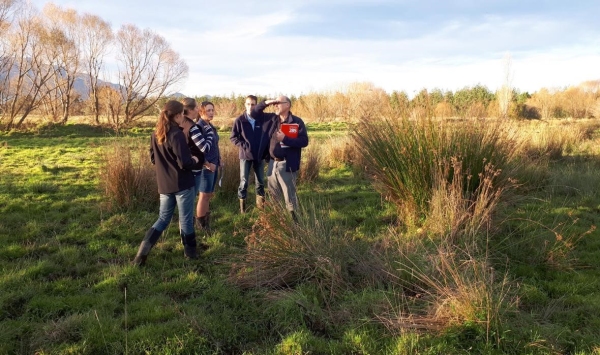A project to restore a stream catchment in Kaikōura—damaged in the 2016 earthquake—is being described as inspirational by NIWA scientists.
Freshwater ecologist Dr Richard Storey praised the group responsible for driving a plan to restore the Lyell Creek/Waikōau catchment, saying it was an example of how a community dealing with a lot of problems was able to find a way to achieve something positive.
“It’s fantastic to see a community-led project that will have significant benefits for future generations,” Dr Storey said.
Making local streams swimmable
The catchment has had a number of problems for some time. Environment Canterbury Kaikōura Branch Manager, Kevin Heays, said in pre-European times it was a swamp but had subsequently become a farming region. The catchment comprises a series of small, spring-fed steams on the Kaikōura Flats; most dairy farms in the areadrain into local streams as does urban run-off from parts of Kaikōura town.
A community group started the restoration process back in the 1990s, persuaded landowners to fence streams, to help suppress an unpleasant smell at the stream mouth in the town whenever it was dredged.
Mr Heays said the Kaikōura Water Zone Committee set up by the Regional Council and comprising community, council and rūnanga representatives passionate about water in Kaikōura, had also been formed with one of its aims being to get the water quality back to swimmable.
“This is a highly visible stream that runs through the town and is extremely important for mahinga kai as well as being highly valued culturally and aesthetically.”
Identifying water quality issues
Following the 2016 earthquake, a working group of the Water Zone Committee assisted the local farming community in securing MPI funding for earthquake recovery—aimed at the farming community on the plains and their business recovery after the quake. The resulting Kaikōura Plains Recovery Project formed with a governance group made up of local farmers, community members and the local rūnanga. One of the workstreams identified by the group was whole catchment recovery and the need for some solid scientific research to help it proceed.
NIWA was then contracted by the Kaikoura Plains Recovery Project to support the work. Dr Storey and colleague Dr Chris Tanner first identified the key issues facing the catchment based on assessment and analysis of previously data collected.
“It had a drainage system to deal with the existing springs but when it all got shaken up, the overflow from the new springs flowed into the streams taking contaminants with it. Some temporary fixes were in place but there was a big problem with water-logging,” Dr Storey said.
The scientists then put forward a series of prioritised steps for improving water quality and habitat, including analyses of costs, benefits and feasibility.
Dr Storey said NIWA’s restoration plan offered a “menu of options” for the community to implement according to their priorities and as time and funding permitted.
Practical steps to improve water and habitat quality included dealing with critical areas such as stock access points and leaks from the sewage system, gradually planting riparian areas starting with the places most visible to the community, and constructing walkways and access points.
Collaborative approach to restoration
Kaikōura Plains Recovery Project Manager Jodie Hoggard said:
“The plans we have received from NIWA will far outlive this project and allow a really good collaborative approach, a clear road map and an opportunity to combine funds for best bang for bucks. The farming community will see good gains from this also, for the issues they are facing, so it’s urban and rural working together on the same issue”.
NIWA recommended continued monitoring of known issues such as E.coli levels, nutrient concentrations at new springs and fish numbers and diversity. One of the recommended tools was NIWA’s Stream Health Monitoring and Assessment Kit (SHMAK) which monitors the ecological health of streams use simple but scientifically sound methods.
Dr Storey says while it is still early days for the implementation of the restoration plan, he has been impressed by the process so far.
“It has been community-led from the start and really started with local residents writing to the council to say they wanted to swim in the river again. The council responded by providing support but allowing the community to take the lead. It’s been a great example and is set to become an asset to the Kaikōura community.”

